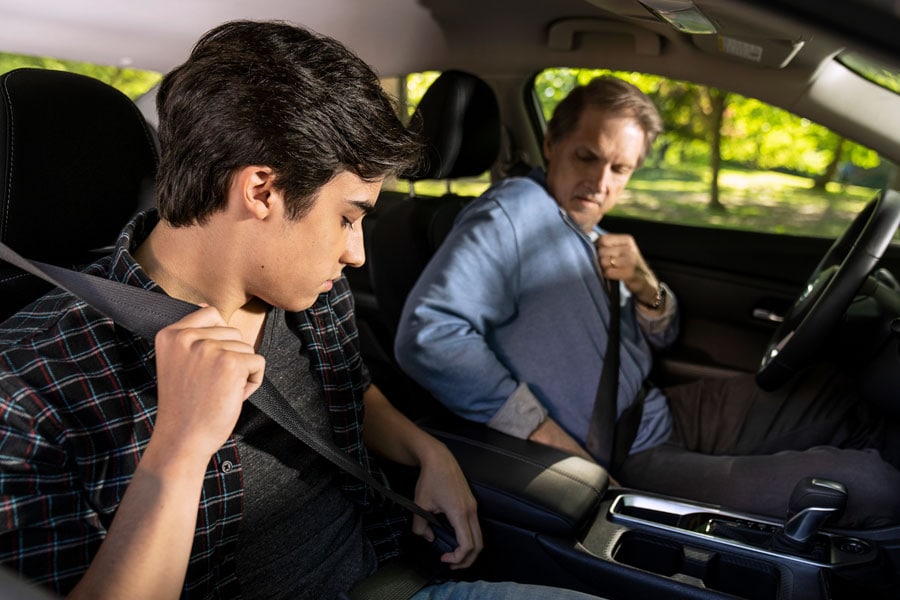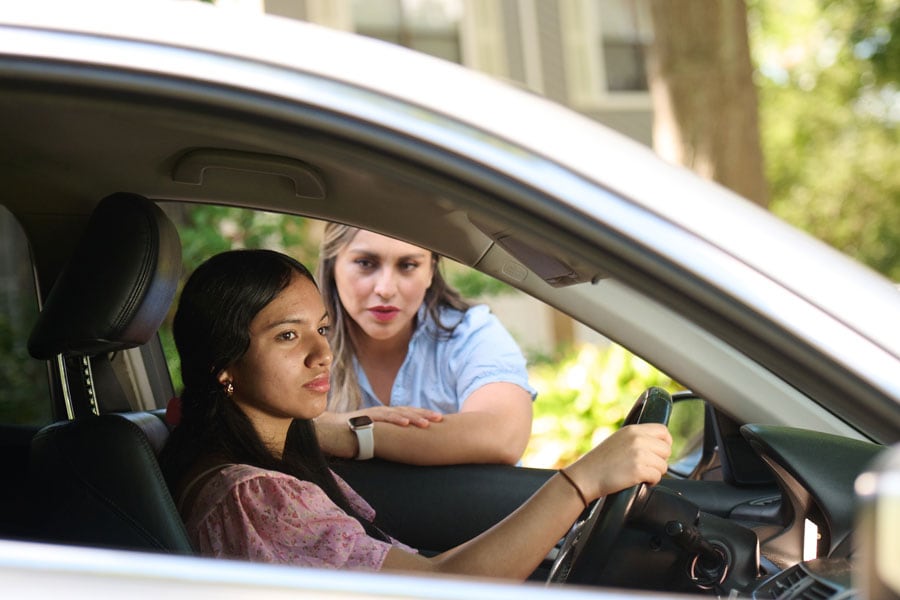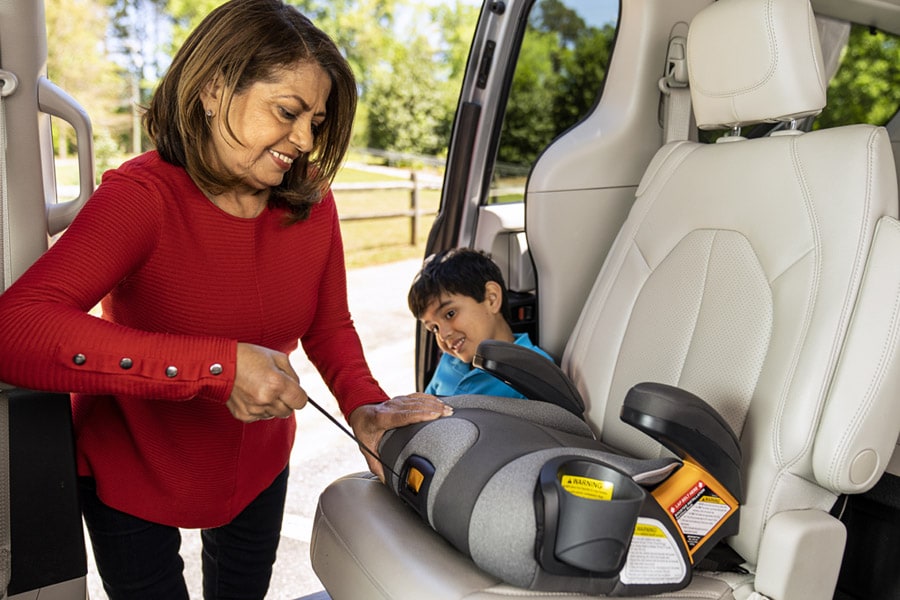The Parents’ Guide to Teen Driving
As parents, teen driving is a milestone we look forward to and dread at the same time. While it can be overwhelming and scary, teaching your teen the rules of the road and letting them leave the driveway with confidence can be a smooth process.
Key steps on your road to success with a teen driver? Patience, practice and trust. Read on for everything you need to get started.
In this article:

Set rules and consider a parent-teen contract
The American Academy of Pediatrics (AAP) and the CDC recommend parents create a parent-teen driving agreement or contract—and so does Dr. Agarwal. Even before your child starts driving, you can discuss expectations, rules and limits that will address common hazards and also what to do if your child breaks the rules. It’s best to have an open conversation with your teen so they feel like they’re a part of the plan.
The AAP and CDC have put together a premade agreement to make it easy for you, but you can also create your own. Hanging it on the fridge will keep it at the top of everyone’s mind and will allow you to reflect on how things are going each day.
Here in Georgia, some high schools offer a peer-to-peer safety program called Teens in the Driver Seat. The yearlong program focuses on traffic safety and addresses all major risks for teens and is offered in partnership with Safe Kids Georgia.
The bottom line? Teaching your child safe driving habits, setting a good example and making sure your child has lots of driving time under their belt will give you peace of mind while your child is on the road.

Prepare your teen to hit the road
In addition to seat belt safety, once your child starts driving, there is an entirely new set of precautions and dangers to be aware of.
According to the Centers for Disease Control (CDC), car crashes are the leading cause of death in teens. In 2017, 6 teens aged 16 to 19 died every day in car crashes, and hundreds more were injured in the U.S.
“Driving—as parents know—is no easy task,” says Maneesha Agarwal, MD, pediatric emergency medicine physician at Children’s Healthcare of Atlanta. “The good news is there are lots of ways to prepare your child for safe driving.”
It starts with making sure they get the proper training and education they need to hit the road. Here are some things to remember:
Familiarize yourself with the laws in your area: Before your child starts to drive, check your state laws to learn about graduated driver licensing (GDL), a strategy that allows teens to gradually gain certain privileges and develop certain skills. While the actual requirements vary from state to state, the general process looks like this:
- Stage 1: Learner’s permit
- Stage 2: Intermediate license or provisional license
- Stage 3: Unrestricted license
You can read about the laws specific to Georgia and find other helpful information (including the Parent/Teen Driving Guide) on the Georgia Department of Driver Services website.
Practice, practice, practice: Try to set aside at least 30 minutes every week to practice driving with your teen, both before they get their license and after.
“Practicing will improve their skills but can also help you reassess your confidence in your child’s driving abilities,” says Dr. Agarwal. “Make sure you try a variety of different roads, during various times of the day and under a variety of weather and traffic conditions.”
Set a good example: Your children are like sponges, and like with most things, they’re going to soak up everything they can from you when it comes to your driving habits. Make sure you follow the rules of the road, avoid distractions and drive the way you want your teen to drive.
Consider a driver’s education course: In addition to parent-teen driving practice, many parents opt to enroll their child in a driver’s ed course through their school or a local organization. While these programs can teach your child many valuable lessons, remember that you should not rely on these courses to get your child ready for the road. Practicing at home is key too.

Help your child avoid common driving mistakes
Your new driver is inevitably going to make some errors along the way, but your job as their parent is to lower the risk of serious slipups. In order to do that, you’ll want to understand some of the most common driving mistakes and work with your child so they know how to prevent them.
1. Failure to anticipate upcoming hazards: “Because of their inexperience, teen drivers tend to fixate on the nearest hazard and have difficulty looking ahead to anticipate additional hazards,” says Dr. Agarwal. “For example, a teen might notice the car slowing down in front of him or her but fail to notice another car that is attempting to merge into his or her lane.” Dr. Agarwal says practice makes all the difference in these scenarios.
2. Becoming distracted: When you hear the term “distracted driving” you may think of cellphones or other handheld devices. And while using them while driving is extremely dangerous and should be avoided (certain states, including Georgia, even have hands-free laws), anything that takes your child’s eyes off the road can interfere with their ability to drive safely. Things like:
- Changing the radio station
- Talking with passengers in the car
- Eating and drinking
- Reaching for something in the car
- Applying makeup
- Connecting wireless devices through Bluetooth or similar (they should connect prior to starting their drive)
Tip from our safety pros: Even though it’s legal to talk on the phone in the car using a hands-free device, it’s safest for teens to focus on the task at hand—driving. Our experts encourage teens at the wheel to keep conversations short.
3. Partaking in risky driving behavior: Children can often be reckless, no matter the activity. But Dr. Agarwal says that risky driving, specifically, is very common, especially when teens are just starting out. Some examples of risky driving behaviors include:
- Speeding
- Slamming on the brakes
- Swerving
- Not wearing seat belts
- Driving while tired
Talk with your child about the consequences of these risky behaviors so that they’re aware of just how life-threatening the habits are.
4. Driving while under the influence of alcohol, drugs or medication: Driving under the influence is against the law, and it’s against the law for minors to drink alcohol or use recreational drugs. In addition to being illegal, operating a vehicle while intoxicated is extremely dangerous, so it’s imperative that you stress this to your child. Discuss what they should do if they ever find themselves in a situation in which they’ve been drinking, have been using recreational drugs or have taken medications that affect their ability to drive. They should always call a responsible and sober family member or friend to come get them.
“And remember that driving without a license or without an adult with only a learner’s permit is against the law,” says Dr. Agarwal.
If your child has an injury or is showing signs of illness, call your doctor or visit an urgent care center. If your child has a life-threatening injury or illness, is having trouble breathing or is unconscious, call 911 and/or visit an emergency department immediately.

